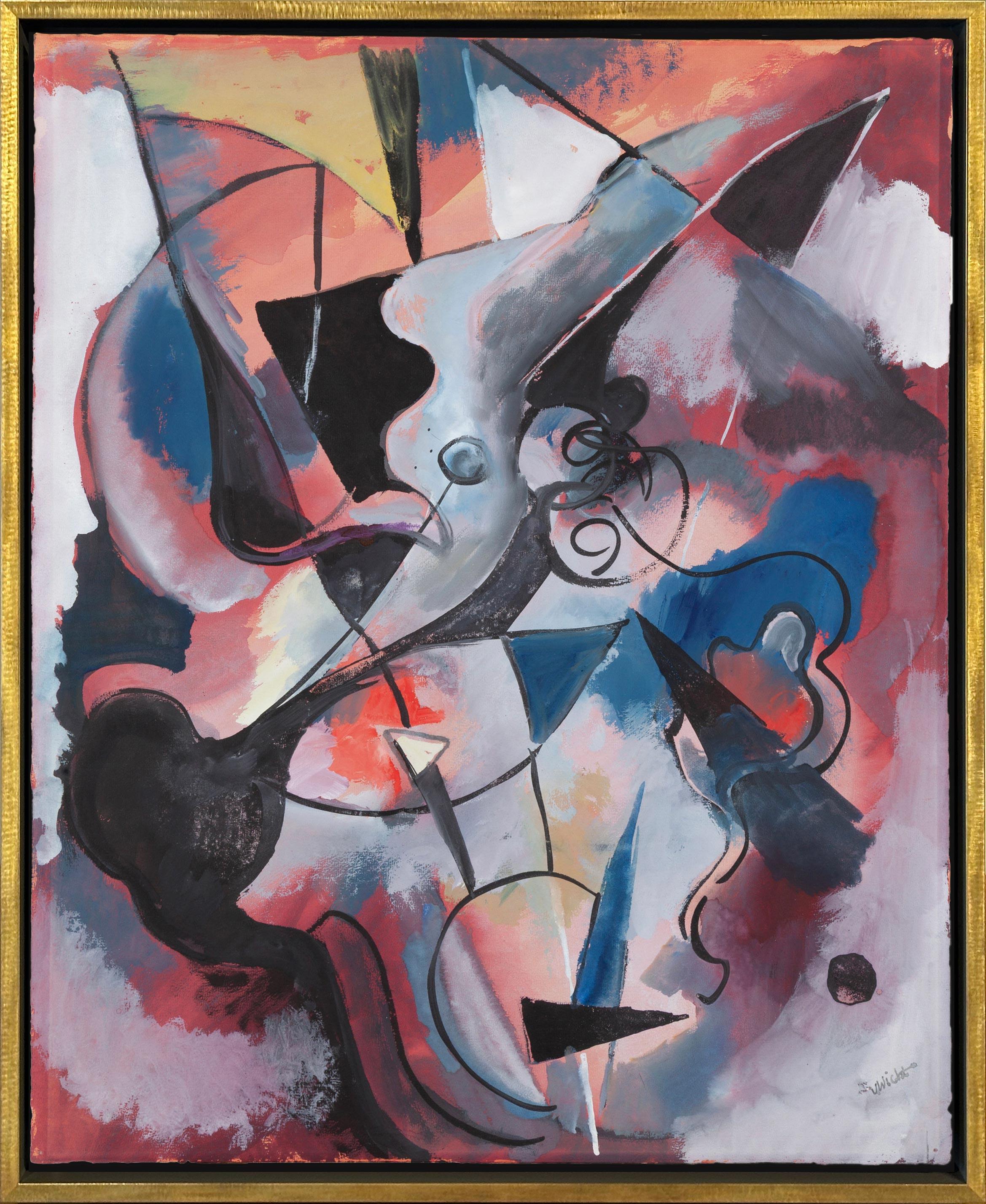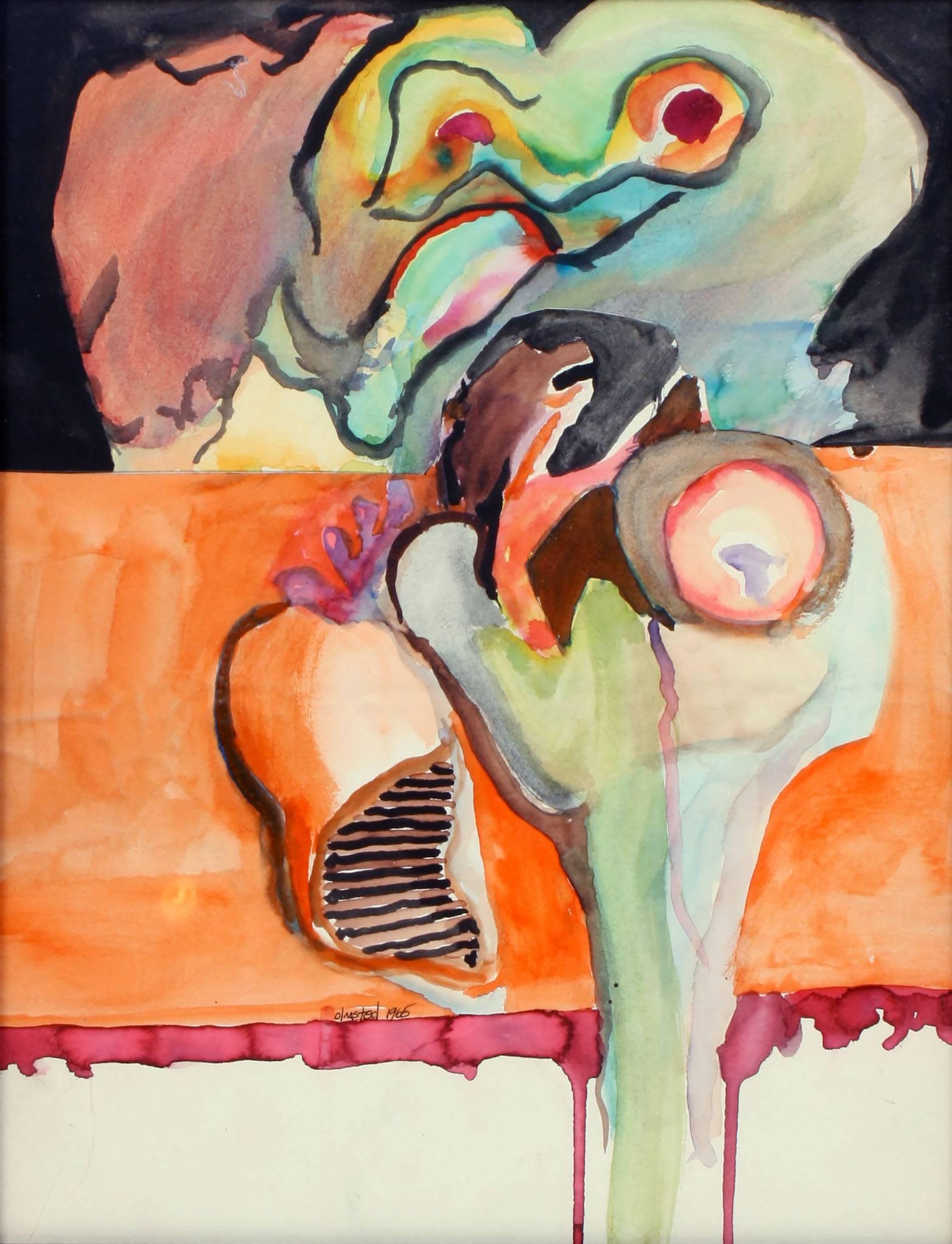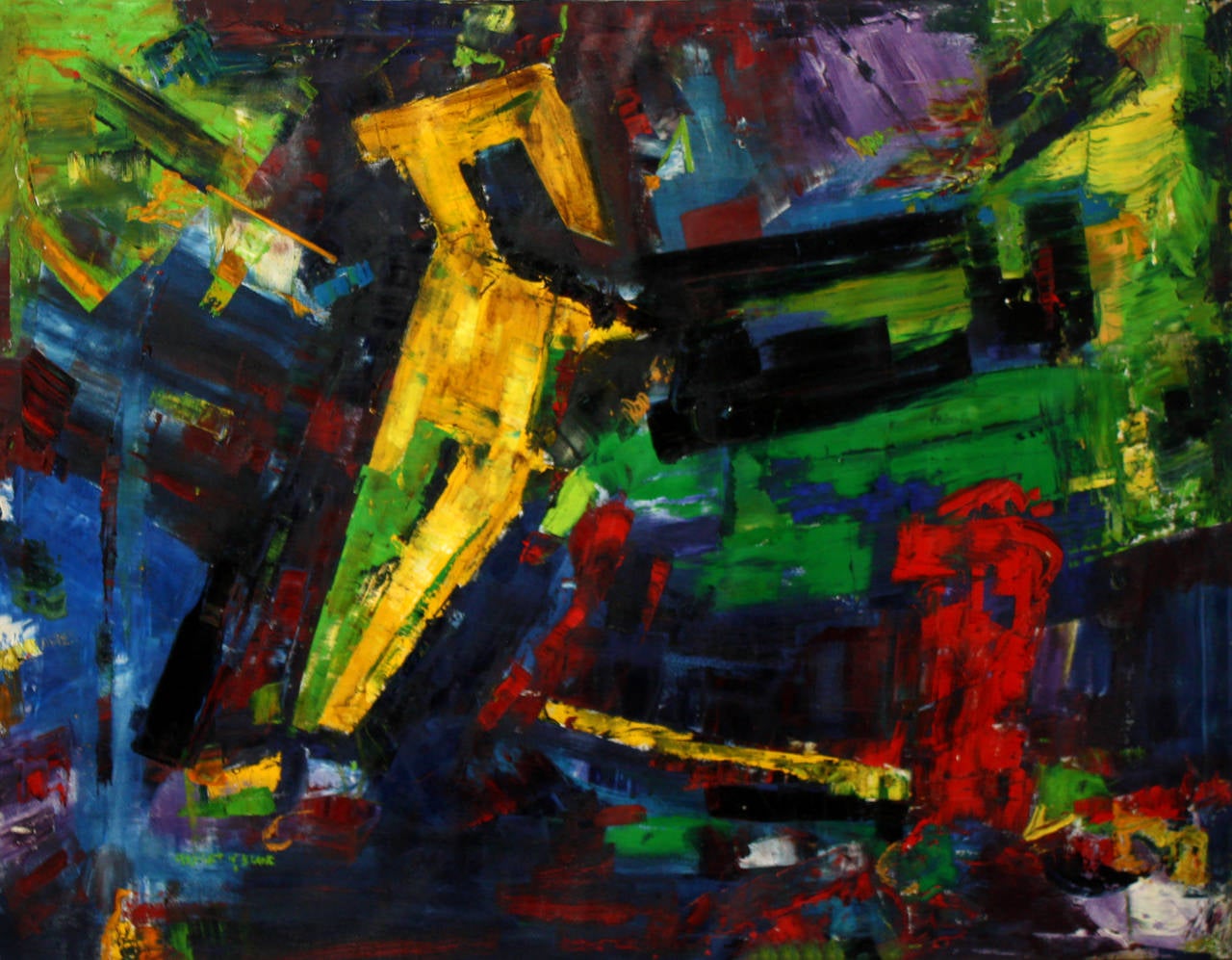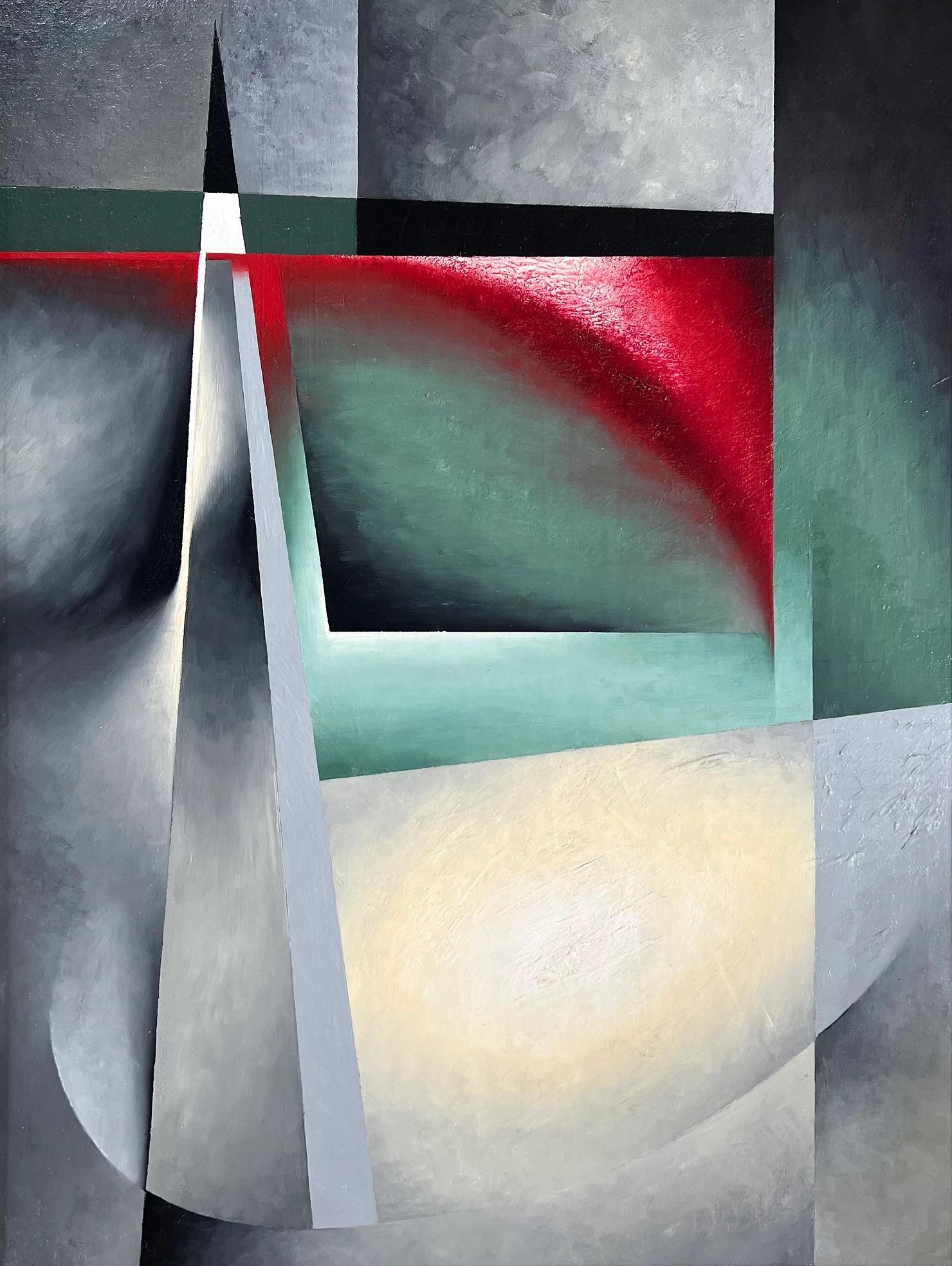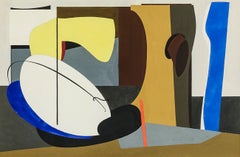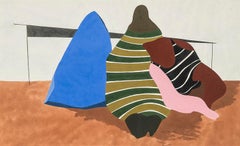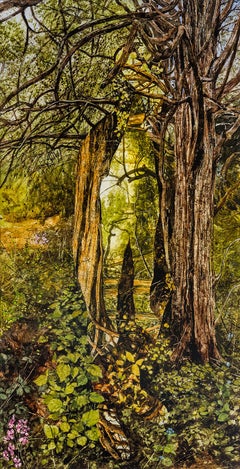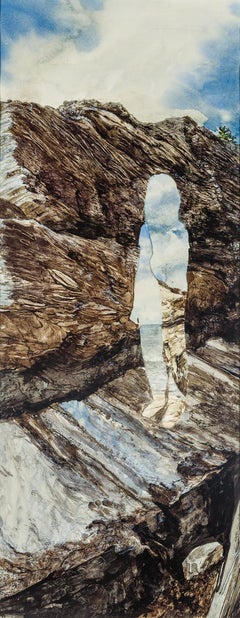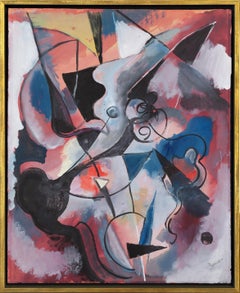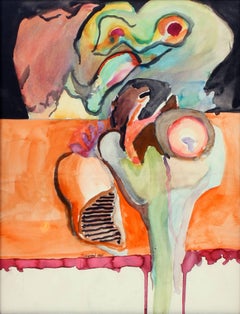Want more images or videos?
Request additional images or videos from the seller
1 of 8
George L.K. MorrisUntitled [Abstraction]c. late 1940s
c. late 1940s
$45,000
£34,417.11
€39,386.97
CA$64,047.35
A$69,344.62
CHF 36,867.34
MX$836,343.90
NOK 463,627.59
SEK 432,232.96
DKK 294,170.76
About the Item
Gouache on paper, 18 7/8 x 14 3/4 in.
Signed (at lower right): Morris; (with monogram, on the back): GLKM [monogram] / 1932 [sic]
Executed circa late 1940s
A passionate advocate of abstract art during the 1930s and 1940s, George L. K. Morris was active as a painter, sculptor, editor, and critic. An erudite man with an internationalist point of view, Morris
eschewed the social, political, and figural concerns that preoccupied so many artists of Depression-era America, believing that painters should focus their attention on the beauty, refinement, and simplicity of pure form instead. His goal, he said, was “to wedge the expression further and further into the confines of the canvas until every shape takes on a spatial meaning” (as quoted in Ward Jackson, “George L. K. Morris: Forty Years of Abstract Art,” Art Journal 32 [Winter 1972–73], p. 150).
Born into an affluent family in New York City, Morris was a descendent of General Lewis Morris, a
signer of the Declaration of Independence. From 1918 until 1924, he attended the Groton School in
Connecticut, studying classics and art. He continued to focus on literature and art while attending
Yale University (1924–28), an experience that prepared him well for his future activity as an artist-critic. After graduating in 1928, Morris studied at the Art Students League of New York, working
under the realist painters John Sloan and Kenneth Hayes Miller, as well as Jan Matulka, the only
modernist on the faculty. In the spring of 1929, Morris traveled to Paris with Albert E. Gallatin, a
family friend and fellow painter who introduced him to leading members of the Parisian avant-garde, including Jean Arp, Pablo Picasso, Georges Braque, Jean Hélion, and Piet Mondrian. Morris also took classes at the Académie Moderne, studying under Fernand Léger and Amédée Ozenfant, important exponents of Synthetic Cubism who influenced his aesthetic development. Indeed, after experimenting with the simplified forms of Modernism for a few years, Morris moved on to abstraction by 1934, adopting a hard-edged, geometric approach inspired by Leger’s cubist style and the biomorphic shapes of Arp and Joan Miró.
Following his return to New York in 1930, Morris built a white-walled, open-spaced studio (inspired
by that of Ozenfant, which had been designed by Le Corbusier) on the grounds of Brockhurst, his
parents’ 46-acre estate in Lenox, Massachusetts. In 1935, he married the painter and collagist Estelle “Suzy” Frelinghuysen (1911–1988), who shared his penchant for abstraction. One year later, the couple helped found American Abstract Artists, a group of forward-thinking artists dedicated to promoting geometric abstraction in the United States.
Untitled features a tight, mosaic-like network of squares (some plain, others embedded with circles) contained within carefully delineated contours set against a backdrop of radiating color planes that converge on the segmented disc that serves as the focal point of the composition. (The evolution of Morris’s style, as he moved from a tentative modernist aesthetic to the type of geometric abstraction exemplified in Untitled is apparent upon perusal of the verso of the sheet, which features a watercolor study from 1932. The summarily rendered shapes suggest the influence of Henri Matisse, who Morris had met in New York in 1931, while the fragmented lines point to his growing penchant for Cubism. Despite the high degree of stylization, however, the site can easily be identified as the Pulitzer Fountain in Manhattan’s Grand Army Plaza [at the southeast entrance to Central Park across from the Plaza Hotel], a well-known landmark crowned by Karl Bitter’s allegorical bronze sculpture, Pomona, the Roman goddess of abundance [erected 1916].) By altering the sizes of the patches and juxtaposing solid areas of color (blue, black, and white) with subtle greys, tans, and pale pinks, Morris creates a tunnel-like sense of depth while retaining the tension and structural integrity of the two-dimensional picture plane. The artist’s kaleidoscope-like arrangement of planar forms readily brings to mind the words of the critic Frank Getlein, who described the effect as being “somewhat similar to that of looking down the well of a staircase” (Frank Getlein, “Knaths and Morris in Washington,” The New Republic 152 [May 15, 1965], n.p.).
In 1941, Morris and Freylinghusen added a streamlined, Bauhaus-inspired residence (designed by
John Butler Swann) on to their Lenox studio, selling one of their Picassos to underwrite the cost.
(Decorated with their own frescoes, modernist furniture, and their extensive collection of abstract art, the Frelinghuysen Morris House & Studio is listed on the National Register of Historic Places and has been open to the public since 1998.) After his solo debut at the Valentine Gallery in New York in 1933, Morris went on to exhibit his work in other leading commercial establishments, among them Edith Halpert’s legendary Downtown Gallery, the Reinhardt Galleries, the Alan Gallery, and Hirschl & Adler Galleries, as well as at venues abroad, including Galerie Pierre and Galerie Colette Allendy in Paris and the Mayor Gallery in London. He also had one-man shows at the Berkshire Museum in 1933 and 1966 and at Yale University in 1935. Morris likewise participated in the annual exhibitions at the National Academy of Design, the Whitney Museum of American Art, the Pennsylvania Academy of the Fine Arts, the Carnegie Institute, and the Art Institute of Chicago. He continued to exhibit his work into the early 1970s, winning the National Academy’s Saltus Gold Medal in 1973. Morris died on June 26, 1975, following an automobile accident near Stockbridge, Massachusetts.
- Creator:George L.K. Morris (1905-1975, American)
- Creation Year:c. late 1940s
- Dimensions:Height: 18.88 in (47.96 cm)Width: 14.75 in (37.47 cm)
- Medium:
- Movement & Style:
- Period:
- Condition:
- Gallery Location:New York, NY
- Reference Number:Seller: APG 89411stDibs: LU2310170802
About the Seller
5.0
Recognized Seller
These prestigious sellers are industry leaders and represent the highest echelon for item quality and design.
Established in 1952
1stDibs seller since 2010
35 sales on 1stDibs
Associations
Art Dealers Association of America
- ShippingRetrieving quote...Shipping from: New York, NY
- Return Policy
More From This Seller
View AllUntitled
By Charles Houghton Howard
Located in New York, NY
Charles Houghton Howard was born in Montclair, New Jersey, the third of five children in a cultured and educated family with roots going back to the Massachusetts Bay colony. His father, John Galen Howard, was an architect who had trained at M.I.T. and the École des Beaux-Arts in Paris and apprenticed in Boston with Henry Hobson Richardson. In New York, the elder Howard worked for McKim, Mead and White before establishing a successful private practice. Mary Robertson Bradbury Howard, Charles’s mother, had studied art before her marriage. John Galen Howard moved his household to California in 1902 to assume the position of supervising architect of the new University of California campus at Berkeley and to serve as Professor of Architecture and the first Dean of the School of Architecture (established in 1903). The four Howard boys grew up to be artists and all married artists, leaving a combined family legacy of art making in the San Francisco Bay area that endures to this day, most notably in design, murals, and reliefs at the Coit Tower and in buildings on the Berkeley campus.
Charles Howard graduated from the University of California at Berkeley in 1921 as a journalism major and pursued graduate studies in English at Harvard and Columbia Universities before embarking on a two-year trip to Europe. Howard went to Europe as a would-be writer. But a near-religious experience, seeing a picture by Giorgione in a remote town outside of Venice, proved a life-altering epiphany. In his own words, “I cut the tour at once and hurried immediately back to Paris, to begin painting. I have been painting whenever I could ever since” (Charles Howard, “What Concerns Me,” Magazine of Art 39 [February 1946], p. 63). Giorgione’s achievement, in utilizing a structured and rational visual language of art to convey high emotion on canvas, instantly convinced Howard that painting, and not literature, offered the best vehicle to express what he wanted to say. Howard returned to the United States in 1925, confirmed in his intent to become an artist.
Howard settled in New York and supported himself as a painter in the decorating workshop of Louis Bouché and Rudolph Guertler, where he specialized in mural painting. Devoting spare time to his own work, he lived in Greenwich Village and immersed himself in the downtown avant-garde cultural milieu. The late 1920s and early 1930s were the years of Howard’s art apprenticeship. He never pursued formal art instruction, but his keen eye, depth of feeling, and intense commitment to the process of art making, allowed him to assimilate elements of painting intuitively from the wide variety of art that interested him. He found inspiration in the modernist movements of the day, both for their adherence to abstract formal qualities and for the cosmopolitan, international nature of the movements themselves. Influenced deeply by Surrealism, Howard was part of a group of American and European Surrealists clustered around Julien Levy. Levy opened his eponymously-named gallery in 1931, and rose to fame in January 1932, when he organized and hosted Surrealisme, the first ever exhibition of Surrealism in America, which included one work by Howard. Levy remained the preeminent force in advocating for Surrealism in America until he closed his gallery in 1949. Howard’s association with Levy in the early 1930s confirms the artist’s place among the avant-garde community in New York at that time.
In 1933, Howard left New York for London. It is likely that among the factors that led to the move were Howard’s desire to be a part of an international art community, as well as his marriage to English artist, Madge Knight...
Category
20th Century American Modern Abstract Drawings and Watercolors
Materials
Paper, Gouache, Graphite
Untitled
By Charles Houghton Howard
Located in New York, NY
Charles Houghton Howard was born in Montclair, New Jersey, the third of five children in a cultured and educated family with roots going back to the Massachusetts Bay colony. His father, John Galen Howard, was an architect who had trained at M.I.T. and the École des Beaux-Arts in Paris and apprenticed in Boston with Henry Hobson Richardson. In New York, the elder Howard worked for McKim, Mead and White before establishing a successful private practice. Mary Robertson Bradbury Howard, Charles’s mother, had studied art before her marriage. John Galen Howard moved his household to California in 1902 to assume the position of supervising architect of the new University of California campus at Berkeley and to serve as Professor of Architecture and the first Dean of the School of Architecture (established in 1903). The four Howard boys grew up to be artists and all married artists, leaving a combined family legacy of art making in the San Francisco Bay area that endures to this day, most notably in design, murals, and reliefs at the Coit Tower and in buildings on the Berkeley campus.
Charles Howard graduated from the University of California at Berkeley in 1921 as a journalism major and pursued graduate studies in English at Harvard and Columbia Universities before embarking on a two-year trip to Europe. Howard went to Europe as a would-be writer. But a near-religious experience, seeing a picture by Giorgione in a remote town outside of Venice, proved a life-altering epiphany. In his own words, “I cut the tour at once and hurried immediately back to Paris, to begin painting. I have been painting whenever I could ever since” (Charles Howard, “What Concerns Me,” Magazine of Art 39 [February 1946], p. 63). Giorgione’s achievement, in utilizing a structured and rational visual language of art to convey high emotion on canvas, instantly convinced Howard that painting, and not literature, offered the best vehicle to express what he wanted to say. Howard returned to the United States in 1925, confirmed in his intent to become an artist.
Howard settled in New York and supported himself as a painter in the decorating workshop of Louis Bouché and Rudolph Guertler, where he specialized in mural painting. Devoting spare time to his own work, he lived in Greenwich Village and immersed himself in the downtown avant-garde cultural milieu. The late 1920s and early 1930s were the years of Howard’s art apprenticeship. He never pursued formal art instruction, but his keen eye, depth of feeling, and intense commitment to the process of art making, allowed him to assimilate elements of painting intuitively from the wide variety of art that interested him. He found inspiration in the modernist movements of the day, both for their adherence to abstract formal qualities and for the cosmopolitan, international nature of the movements themselves. Influenced deeply by Surrealism, Howard was part of a group of American and European Surrealists clustered around Julien Levy. Levy opened his eponymously-named gallery in 1931, and rose to fame in January 1932, when he organized and hosted Surrealisme, the first ever exhibition of Surrealism in America, which included one work by Howard. Levy remained the preeminent force in advocating for Surrealism in America until he closed his gallery in 1949. Howard’s association with Levy in the early 1930s confirms the artist’s place among the avant-garde community in New York at that time.
In 1933, Howard left New York for London. It is likely that among the factors that led to the move were Howard’s desire to be a part of an international art community, as well as his marriage to English artist, Madge Knight...
Category
20th Century American Modern Abstract Drawings and Watercolors
Materials
Paper, Watercolor, Gouache, Graphite
Many-Worlds Interpretation (C.D.H.S.c)
By Colin Hunt
Located in New York, NY
Looking at a painting by Colin Hunt is like watching someone pass through a hole in our consciousness. As the landscape refracts through the sitter’s absence and fills that emptiness...
Category
2010s Abstract Abstract Drawings and Watercolors
Materials
Watercolor
Many-Worlds Interpretation (H.C.H.C.E.c)
By Colin Hunt
Located in New York, NY
Looking at a painting by Colin Hunt is like watching someone pass through a hole in our consciousness. As the landscape refracts through the sitter’s absence and fills that emptiness...
Category
2010s Abstract Abstract Drawings and Watercolors
Materials
Watercolor
Excavation
By Charles Houghton Howard
Located in New York, NY
Charles Houghton Howard was born in Montclair, New Jersey, the third of five children in a cultured and educated family with roots going back to the Massachusetts Bay colony. His father, John Galen Howard, was an architect who had trained at M.I.T. and the École des Beaux Arts in Paris, and apprenticed in Boston with H. H. Richardson. In New York, the elder Howard worked for McKim, Mead and White before establishing a successful private practice. Mary Robertson Bradbury, Charles’s mother, had studied art before her marriage. John Galen Howard moved his household to California in 1902 to assume the position of supervising architect of the new University of California campus at Berkeley and to serve as Professor of Architecture and the first Dean of the School of Architecture (established in 1903). The four Howard boys grew up to be artists and all married artists, leaving a combined family legacy of art making in the San Francisco Bay area that endures to this day, most notably in design, murals and reliefs at the Coit Tower and in buildings on the Berkeley campus.
Charles Howard graduated from the University of California at Berkeley in 1921 as a journalism major, and pursued graduate studies in English at Harvard and Columbia Universities before embarking on a two-year trip to Europe. Howard went to Europe as a would-be writer. But a near-religious experience, seeing a picture by Giorgione in a remote town outside of Venice, proved a life-altering epiphany. In his own words, “I cut the tour at once and hurried immediately back to Paris, to begin painting. I have been painting whenever I could ever since” (Charles Howard, “What Concerns Me,” Magazine of Art 39, no. 2 [February 1946], p. 63). Giorgione’s achievement, in utilizing a structured and rational visual language of art to convey high emotion on canvas, instantly convinced Howard that painting, and not literature, offered the best vehicle to express what he wanted to say. Howard returned to the United States in 1925, confirmed in his intent to become an artist.
Howard settled in New York and supported himself as a painter in the decorating workshop of Louis Bouché and Rudolph Guertler, where he specialized in mural painting. Devoting spare time to his own work, he lived in Greenwich Village and immersed himself in the downtown avant-garde cultural milieu. The late 1920s and early 1930s were the years of Howard’s art apprenticeship. He never pursued formal art instruction, but his keen eye, depth of feeling, and intense commitment to the process of art making, allowed him to assimilate elements of painting intuitively from the wide variety of art that interested him. He found inspiration in the modernist movements of the day, both for their adherence to abstract formal qualities and for the cosmopolitan, international nature of the movements themselves. Influenced deeply by Surrealism, Howard was part of a group of American and European Surrealists clustered around Julien Levy. Levy opened his eponymously-named gallery in 1931, and rose to fame in January 1932, when he organized and hosted Surrealisme, the first ever exhibition of Surrealism in America, which included one work by Howard. Levy remained the preeminent force in advocating for Surrealism in America until he closed his gallery in 1949. Howard’s association with Levy in the early 1930s confirms the artist’s place among the avant-garde community in New York at that time.
In 1933, Howard left New York for London. It is likely that among the factors that led to the move were Howard’s desire to be a part of an international art community, as well as his marriage to English artist, Madge Knight...
Category
20th Century American Modern Abstract Paintings
Materials
Canvas, Oil
Untitled
By Louis Elle (Ferdinand)
Located in New York, NY
Oil on canvas, 14 x 12 in.
Category
Late 20th Century American Modern Paintings
Materials
Canvas, Oil
You May Also Like
Untitled II
By Joseph Zirker
Located in San Francisco, CA
Artist: Joseph Zirker (American, born 1924)
Title: Untitled
Year: 1988
Medium: Color monotype
Paper: Arche 88
Size: 42 x 30 inches
Signature: Signed and dated in pencil by the artist
Printer: The artist
Condition: Very good
Frame: Unframed
About the artist.
Joseph Zirker is a noted American modern artist, educator, lecturer that was born on August 13, 1924 in Los Angeles, California, United States. As a young man he Served with United States Navy, from 1944 to 1946.
He attended the University of California in Los Angeles 1946—1947. He got a bachelor of Fine Arts at the University of Denver in 1949 and a master of Fine Arts, University Southern California, 1951.
He was a printer and research fellow at Tamarind Lithography Workshop in Los Angeles, 1961—1963. Lecturer University Southern California, 1963. Instructor Los Angeles County Art Institute, 1964, San Jose City College, California, 1966—1980.
Lecturer Stanford University, 1981—1983, 1986—1990. All along his carer, he had numerous acclaimed shows in the U.S and abroad. He is known worldwide as an innovator in monotype and printmaking. His works are represented in private and public collections, both in the USA and worldwide, including:
Grunwald Collection, U.C.L.A., Los Angeles, California,
Brooklyn Museum, Brooklyn, New York
Free Library of Philadelphia, Pennsylvania
June Wayne, Tamarind Lithography Workshop, Los Angeles, California
Tamarind Archives, Tamarind Lithography Workshop, Los Angeles, California,
Charles White, Los Angeles, California
Stanley Freeman Collection, Los Angeles County Museum, Los Angeles, California
Ben Smith...
Category
Late 20th Century American Modern Abstract Prints
Materials
Monotype
Untitled III
By Joseph Zirker
Located in San Francisco, CA
Artist: Joseph Zirker (American, born 1924)
Title: Untitled
Year: 1988
Medium: Color monotype
Paper: Arche 88
Size: 42 x 30 inches
Signature: Signed and dated in pencil by the artist
Printer: The artist
Condition: Very good
Frame: Unframed
About the artist.
Joseph Zirker is a noted American modern artist, educator, lecturer that was born on August 13, 1924 in Los Angeles, California, United States. As a young man he Served with United States Navy, from 1944 to 1946.
He attended the University of California in Los Angeles 1946—1947. He got a bachelor of Fine Arts at the University of Denver in 1949 and a master of Fine Arts, University Southern California, 1951.
He was a printer and research fellow at Tamarind Lithography Workshop in Los Angeles, 1961—1963. Lecturer University Southern California, 1963. Instructor Los Angeles County Art Institute, 1964, San Jose City College, California, 1966—1980.
Lecturer Stanford University, 1981—1983, 1986—1990. All along his carer, he had numerous acclaimed shows in the U.S and abroad. He is known worldwide as an innovator in monotype and printmaking. His works are represented in private and public collections, both in the USA and worldwide, including:
Grunwald Collection, U.C.L.A., Los Angeles, California,
Brooklyn Museum, Brooklyn, New York
Free Library of Philadelphia, Pennsylvania
June Wayne, Tamarind Lithography Workshop, Los Angeles, California
Tamarind Archives, Tamarind Lithography Workshop, Los Angeles, California,
Charles White, Los Angeles, California
Stanley Freeman Collection, Los Angeles County Museum, Los Angeles, California
Ben Smith...
Category
Late 20th Century American Modern Abstract Prints
Materials
Monotype
Untitled (6)
By John von Wicht
Located in Columbia, MO
John von Wicht (German-American, 1888 - 1970) was a painter and printmaker whose abstract works evolved from European modernism to dynamic, expressionistic forms. Born in Holstein, G...
Category
Mid-20th Century Abstract Abstract Paintings
Materials
Paper, Oil
Abstract Landscape
By Wes Olmsted
Located in Buffalo, NY
An original watercolor painting by American artist Wes Olmsted depicting an abstract landscape view.
Category
1960s American Modern Abstract Paintings
Materials
Archival Paper, Watercolor
Abstraction
By Robert Noel Blair
Located in Buffalo, NY
You are viewing a modern abstract painting by Robert Blair.
Robert Noel Blair (American, 1912-2003) was an American artist, painter, sculptor, printmaker and teacher. He is best k...
Category
1960s American Modern Abstract Paintings
Materials
Canvas, Oil
$9,600 Sale Price
20% Off
Abstract
Located in Los Angeles, CA
This painting is part of our exhibition Charles Goeller: A Wistful Loneliness.
Oil on canvas, 29 x 22 inches, Signed on frame verso “Painted by Charles L. Goeller”
Exhibited:
(Perh...
Category
1930s American Modern Abstract Paintings
Materials
Oil
More Ways To Browse
Bronze Goddess
Allegorical Sculpture
Declaration Of Independence
Morris Lewis
George L K Morris
Suzy Frelinghuysen
East Africa
Vintage Foster
Abstract Art Diptych
Color Field Abstract
Acrylic Nature Painting
Graffiti Artist
Happy Art
San Francisco Artists
Large Original Art
Large Abstract Painting Of Mountains
Happy Paintings
Abstract Expressionist Ink
